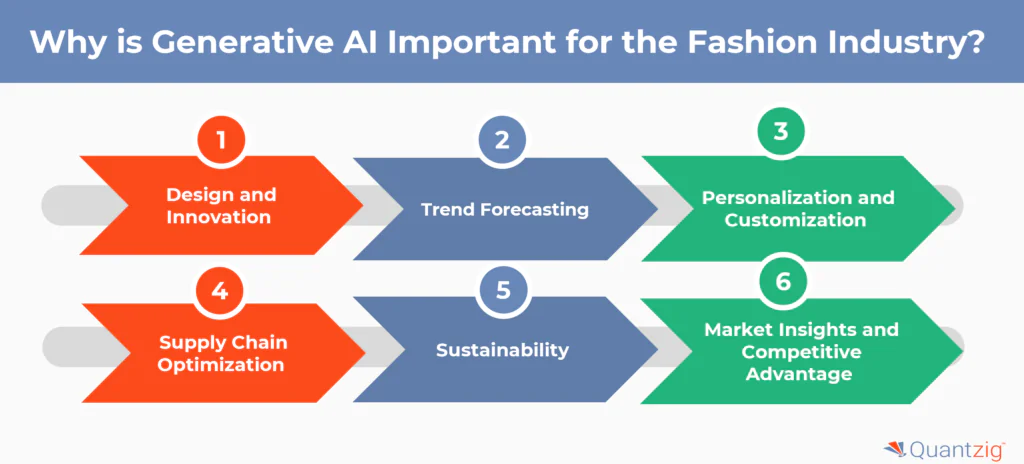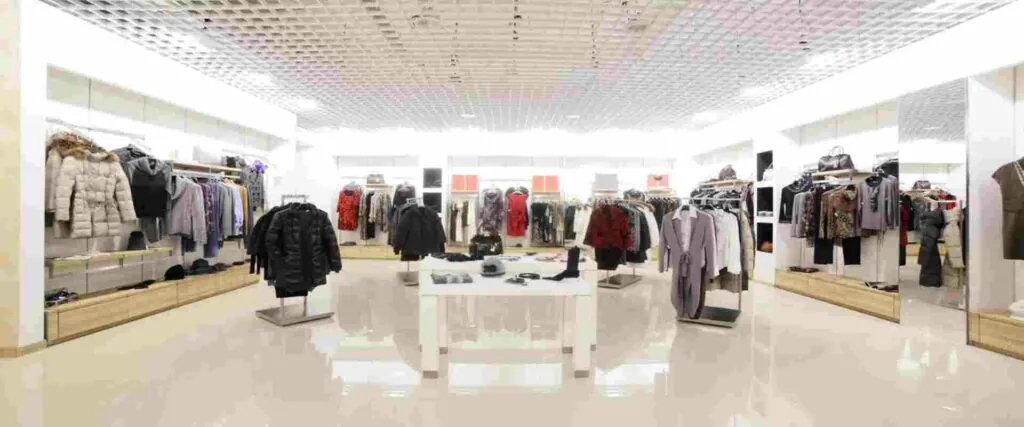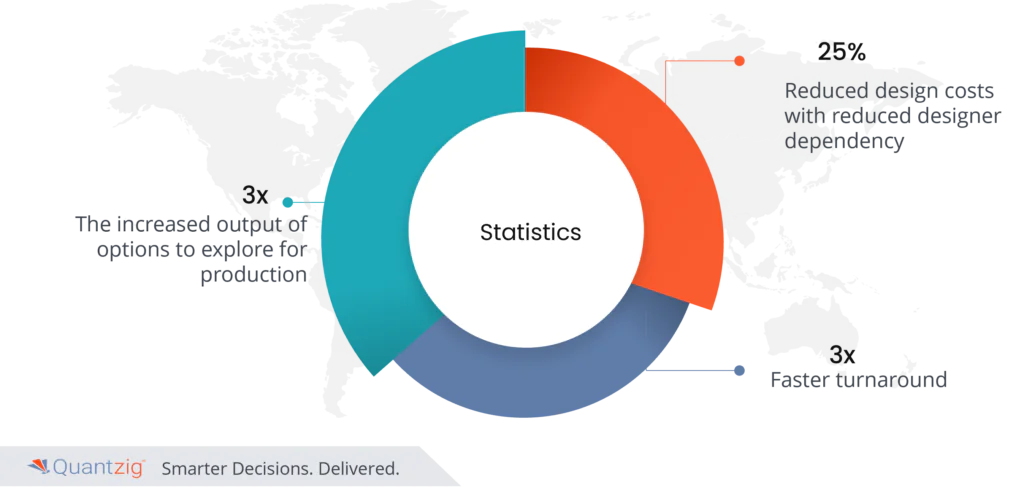Written By: Sudeshna Ghosh
Table of Contents
Introduction to Generative AI for Fashion
Generative artificial intelligence (AI), also known as gen-AI, is an advanced machine learning technology that leverages user prompts, input, or triggers to generate novel content. Currently, text and image generation represent the most prominent applications of this innovative technology. However, there is a growing momentum across various industries and domains to expand the scope of generative AI, exploring its potential in areas such as animation, sound effects, music, virtual character integration, and fashion collection design.
In the fashion industry, the application of generative AI has significant implications for the design and production process. By leveraging AI-generated content, fashion designers can create unique and innovative designs, streamline their workflow, and enhance the overall customer experience. The technology’s ability to generate novel patterns, textures, and styles can also help reduce the environmental impact of the fashion industry by minimizing waste and promoting sustainable practices.
Book a demo to experience the meaningful insights we derive from data through our GenAI tools and platform capabilities. Schedule a demo today!
Request a Free DemoWhy is Generative AI Important for the Fashion Industry?

Generative artificial intelligence (AI) is transforming the fashion industry by revolutionizing the design, production, and marketing processes. This technology has significant implications for fashion brands, enabling them to create innovative designs, streamline their workflow, and enhance the customer experience. Here are some key reasons why generative AI is crucial for the fashion industry:
1. Design and Innovation
Generative AI empowers designers to create unique and innovative designs by leveraging AI-generated content. By inputting parameters such as aesthetic, materials, and target market, AI algorithms can generate new designs that cater to consumer preferences. This technology also enables style transfer, allowing designers to experiment with different styles and create variations on existing designs.
2. Trend Forecasting
This technology can analyze large volumes of social media data to identify emerging trends and predict consumer preferences. This helps fashion brands anticipate and respond to changing consumer behavior, ensuring they stay competitive in the market.
3. Personalization and Customization
AI-driven solutions can provide personalized recommendations for customers based on their preferences and behavior. This includes customized product offerings, tailored marketing content, and enhanced customer service through AI-powered chatbots and virtual assistants.
4. Supply Chain Optimization
Generative AI can optimize production processes by predicting demand and identifying the most efficient production methods. This reduces waste and improves supply chain efficiency, leading to cost savings and increased profitability.
5. Sustainability
AI can help fashion companies become more sustainable by optimizing their supply chain and production processes. By analyzing data, AI can identify areas where waste can be reduced and energy efficiency can be improved.
6. Market Insights and Competitive Advantage
Generative AI provides valuable insights into consumer behavior, preferences, and demographics. This data can inform marketing strategies and product development, giving fashion brands a competitive edge in the market.
According to Quantzig experts, the adoption of generative AI in the fashion industry is expected to contribute an additional $150 billion in revenue over the next three to five years. As the technology continues to evolve, it is likely to play an increasingly significant role in shaping the future of the fashion industry.
How is Generative AI Reshaping the Fashion Landscape?

1. A multitude of options for fashion exploration and experimentation
In the ever-evolving realm of fashion, AI (Artificial Intelligence) stands as a transformative force, reshaping the landscape through a myriad of innovative mechanisms. Firstly, it presents a multitude of options for fashion businesses exploration and experimentation, offering designers a vast spectrum of possibilities to push creative boundaries. This democratization of creativity allows for unparalleled diversity in design, enabling Apparel, fashion, and luxury sectors to cater to varied consumer preferences and stay at the forefront of trends.
As AI (Artificial Intelligence) continues to evolve, it brings about an AI reset in the beauty and luxury sectors as well, driving innovation and efficiency across the board. With advancements in machine learning algorithms, the possibilities for AI in fashion are limitless, promising a future where creativity and technology converge to shape the industry in unprecedented ways.
2. Optimization of design process and timelines
AI technology optimizes the design process and timelines, streamlining workflows and enhancing efficiency. By leveraging Machine Learning algorithms and vast datasets, designers can expedite the ideation, prototyping, and iteration phases. This acceleration not only ensures swift adaptation to emerging trends but also enhances overall productivity, a crucial aspect in the fiercely competitive Fashion businesses. In addition, emerging technologies such as Virtual reality and Augmented reality are reshaping the way Apparel, fashion, and luxury sectors engage with consumers, offering immersive experiences and personalized interactions.
3. Increased customer-level customization with reduced cost of customization and near real-time visibility to stock availability
In the fashion industry, the runway to success has been paved with technological advancements, particularly in data science and generative AI. Designers now have access to powerful tools that enable them to create innovative designs and offer unparalleled customization to their customers. Through social media and virtual try-on solutions, brands can engage directly with their audience, gathering valuable feedback and reviews to inform their design process.
Moreover, generative AI has revolutionized supply chain management in the fashion industry. This not only minimizes overstock but also reduces the risk of stockouts, optimizing supply chain efficiency and reducing costs. Furthermore, the integration of chatbots into the shopping experience enhances customer service, providing assistance and personalized recommendations. This level of personalization not only enhances the shopping experience but also contributes to sustainability efforts by reducing the need for excessive production.
In a nutshell, Generative AI is not merely a technological tool; it is a strategic enabler for fashion brands, offering unprecedented avenues for creativity, operational efficiency, and customer-centricity. As the industry embraces these advancements, it solidifies its position at the cutting edge of innovation and adapts seamlessly to the dynamic demands of the modern fashion landscape. Through personalized recommendations and leveraging data privacy, inclusivity, and convenience, fashion brands can navigate trends while addressing concerns such as job displacement.
Experience the advantages firsthand by testing a customized complimentary pilot designed to address your specific GenAI requirements. Pilot studies are non-committal in nature.
Request a Free PilotTop Areas:

In the relentless arena of fashion, the infusion of AI-supported innovation emerges as the secret weapon for industry pioneers. Artfully blending machine learning algorithms and expansive datasets, this avant-garde approach revolutionizes design dynamics, offering an expansive palette for creative exploration. Beyond aesthetics, it strategically elevates customer experiences, enabling cost-effective, highly personalized products at scale. The alchemy of AI optimizes design timelines, ensuring fashion houses ride the crest of evolving trends.
This transformative wave extends its influence on operational realms, providing real-time insights into stock availability, a game-changer in inventory management. AI-supported fashion innovation becomes the catalyst for agile, responsive supply chains, minimizing overstock pitfalls and averting the threat of stockouts. In this high-stakes fashion landscape, where every stitch and pixel matters, those armed with AI-backed ingenuity emerge not just as competitors but as trailblazers, setting new benchmarks for industry excellence and reshaping the future of fashion.
How does the integration of Generative AI into the world of fashion provide businesses with a lot of benefits?
1. Faster go to market
In the fiercely competitive landscape of the fashion industry, the strategic integration of Generative AI emerges as a catalyst for transformative advantages. Firstly, it propels businesses towards a faster go-to-market strategy by leveraging advanced algorithms and extensive datasets. This dynamic approach not only accelerates the design lifecycle but ensures agile responsiveness to evolving trends, positioning brands at the forefront of innovation and market trends.
2. Increased customizability to suit customer needs
Secondly, Generative AI enhances customizability, offering businesses the ability to tailor products at scale, aligning seamlessly with the diverse and dynamic preferences of the modern consumer. This heightened level of customization fosters brand loyalty and cultivates a personalized connection with the target audience, crucial in today’s consumer-centric landscape.
3. Improved productivity by running through various options
Moreover, the integration of Generative AI amplifies productivity by enabling designers to swiftly navigate through a multitude of creative options. This efficiency-driven approach not only streamlines the creative process but empowers businesses to explore, iterate, and refine ideas with unprecedented speed and precision.
In essence, Generative AI is a strategic imperative for fashion businesses aiming not only to meet but surpass industry benchmarks. By harnessing the power of AI, brands unlock a competitive edge characterized by speed, customization, and innovation, setting new standards for success in the dynamic world of fashion.
What does the Future of Generative AI in Fashion hold?
1. Multiplying the fashion output by providing a base for designers to start
The future of the fashion industry promises a paradigm shift, propelled by the integration of advanced technologies. Firstly, the multiplication of fashion output is on the horizon, with AI acting as the cornerstone for designers. By providing a robust base and automating repetitive tasks, designers can exponentially increase their creative capacity, ushering in an era of innovation and efficiency.
2. Optimized store operations for informed assortment and inventory options
Optimized store operations represent another facet of this transformative future. AI’s analytical prowess offers informed assortment and inventory options, mitigating risks associated with overstock and stockouts. This strategic alignment with real-time data ensures that retailers can meet customer demands accurately, enhancing operational efficiency and profitability.
3. Embedding of recommendation engines and multi-feature simulations to develop more aided customizations supported by AI
Moreover, the future holds the seamless embedding of recommendation engines and multifaceted simulations, revolutionizing customization. AI-driven insights enable brands to offer more sophisticated and personalized products, aligning perfectly with evolving consumer preferences. This augmentation not only elevates customer experiences but sets the stage for a fashion landscape where innovation, efficiency, and personalization converge to define the new standard of success.
Get started with your complimentary trial today and delve into our platform without any obligations. Explore our wide range of customized, data driven GenAI analytical solutions built across the analytical maturity levels.
Start your Free TrialRecent Statistics

- 3x the increased output of options to explore for production
- 25% reduced design costs with reduced designer dependency
- 3x faster turnaround
Conclusion
In conclusion, the integration of Generative AI into the dynamic fashion industry propels us into an era of unparalleled innovation and strategic prowess. As we unlock the future of fashion with this transformative technology, brands gain a competitive edge by harnessing the power of heightened customizability, accelerated design processes, and data-driven operational efficiency. The synergy of creativity and artificial intelligence not only redefines the boundaries of what’s possible but sets the stage for a dynamic industry where adaptation is synonymous with success.
In this fiercely competitive landscape, those who embrace Generative AI not only navigate the evolving currents of trends but emerge as pioneers shaping the very essence of fashion’s future. As the fashion horizon expands with limitless possibilities, the integration of Generative AI stands as the key to unlocking new dimensions, driving brands toward a future where innovation, agility, and customer-centricity reign supreme.



